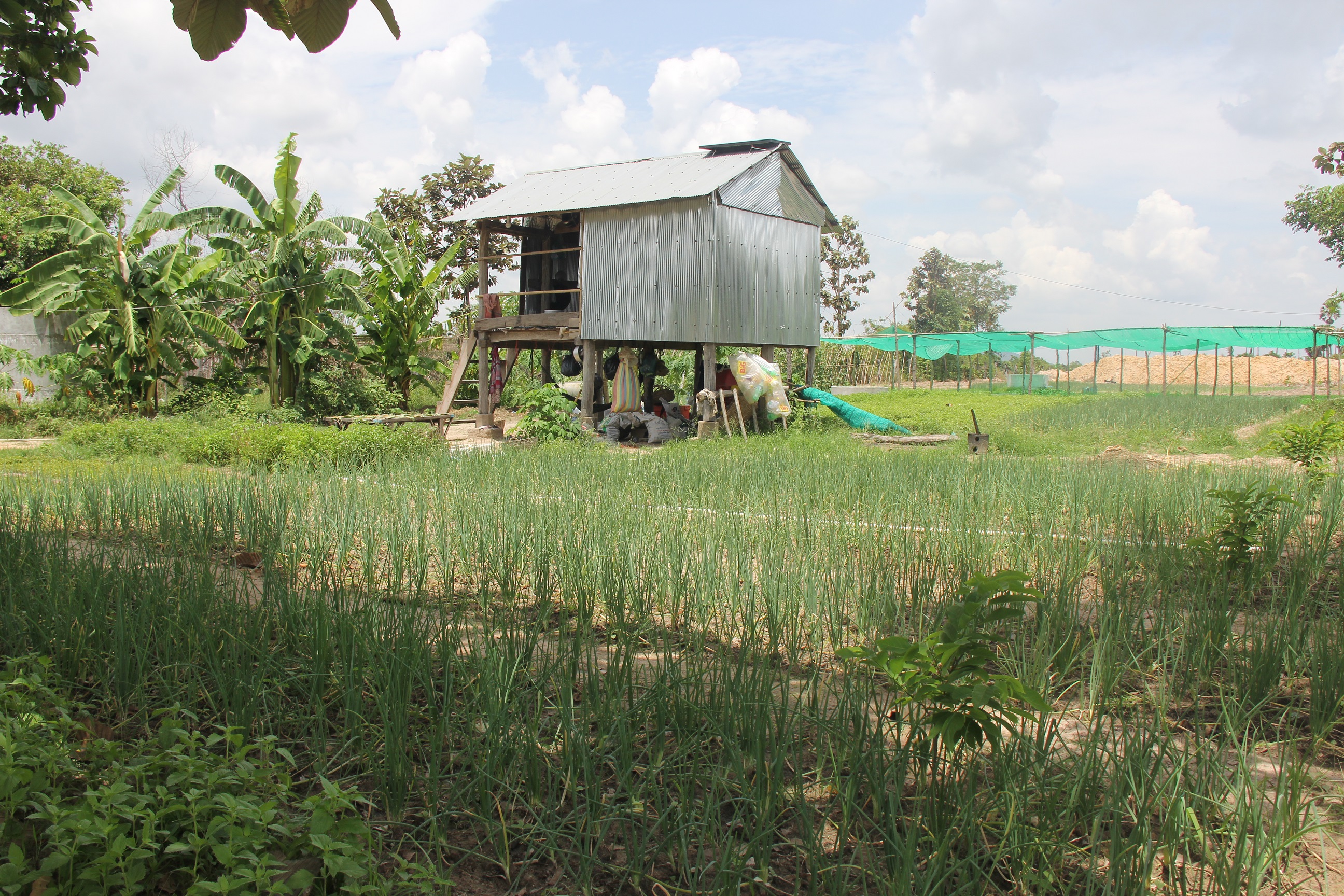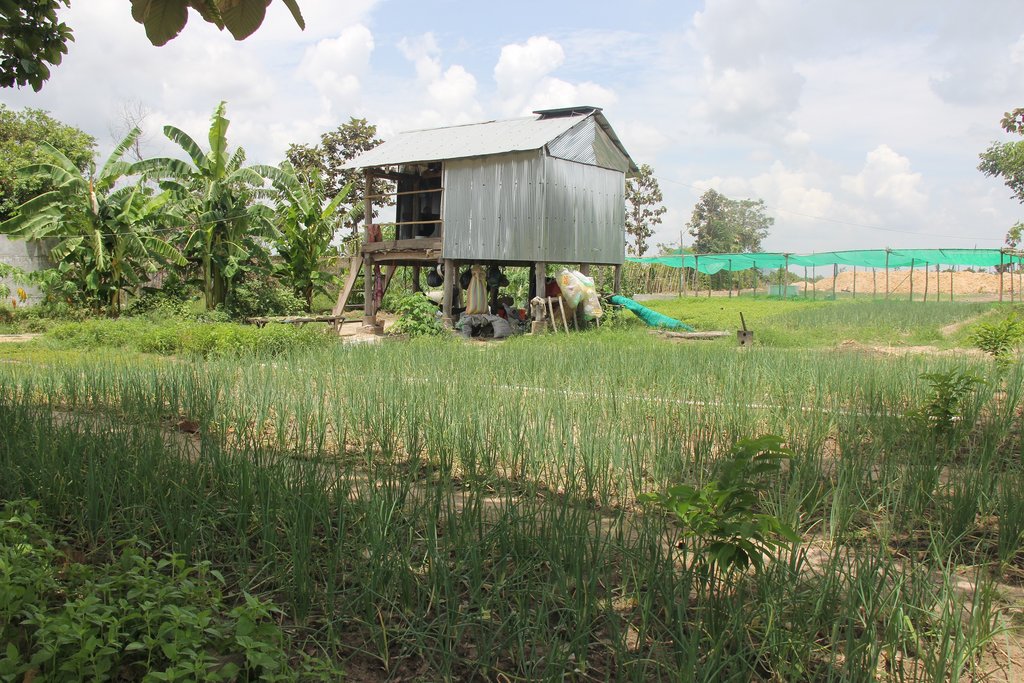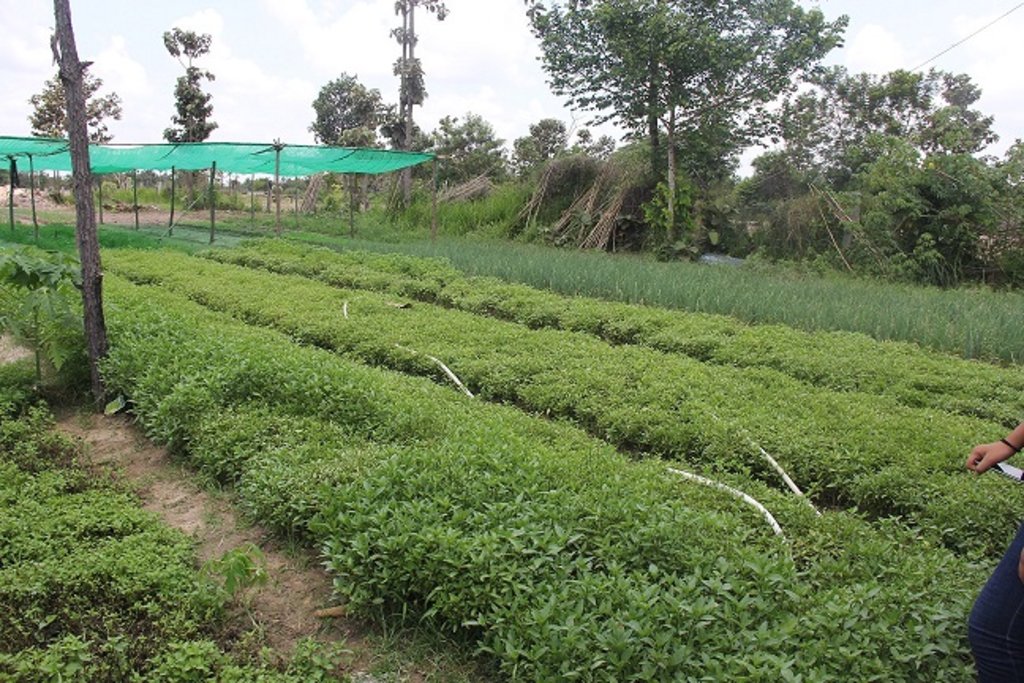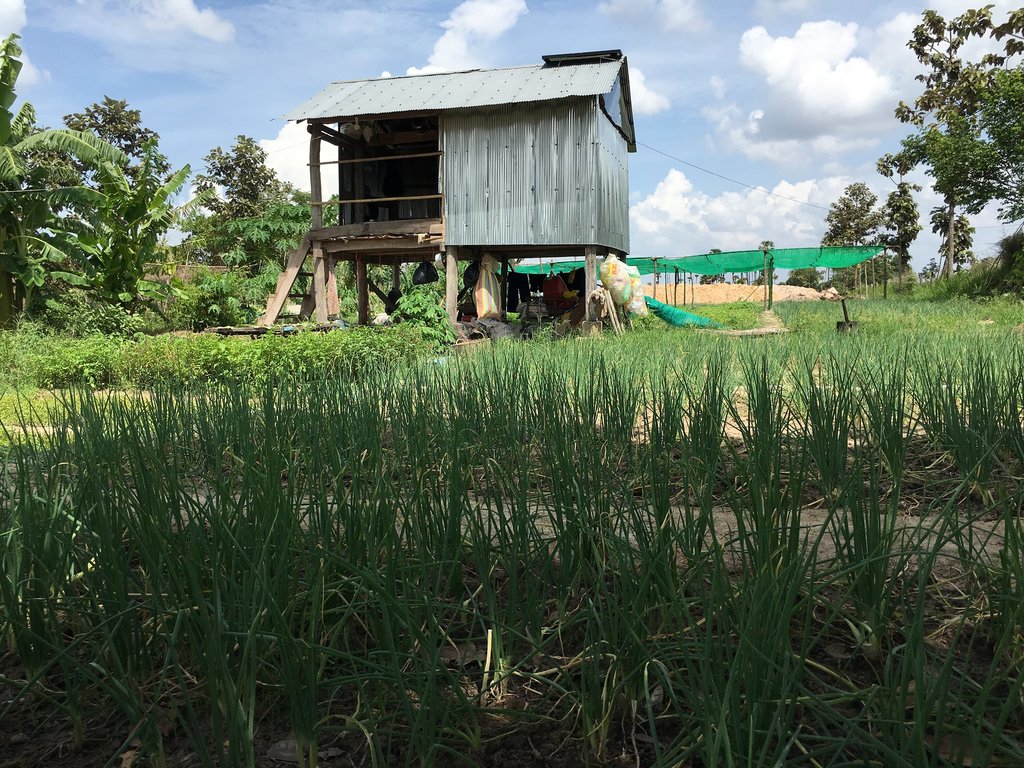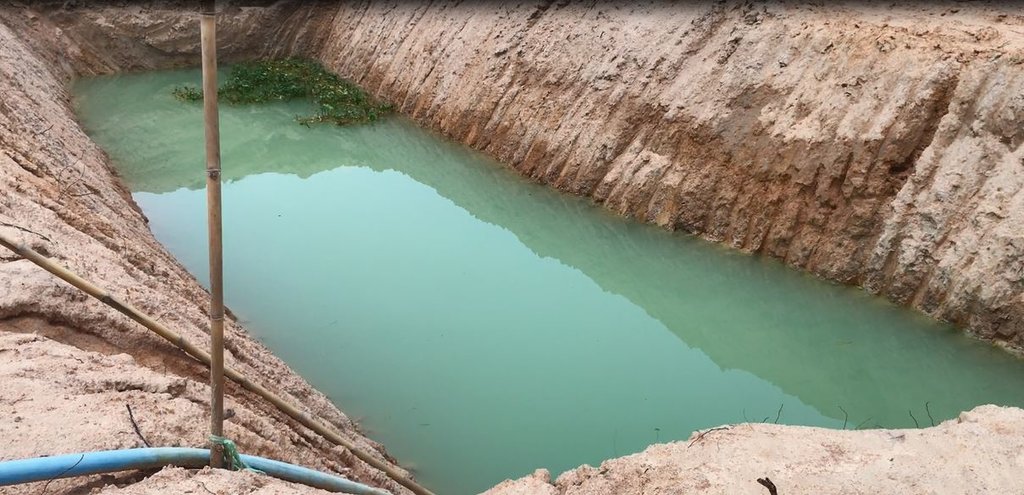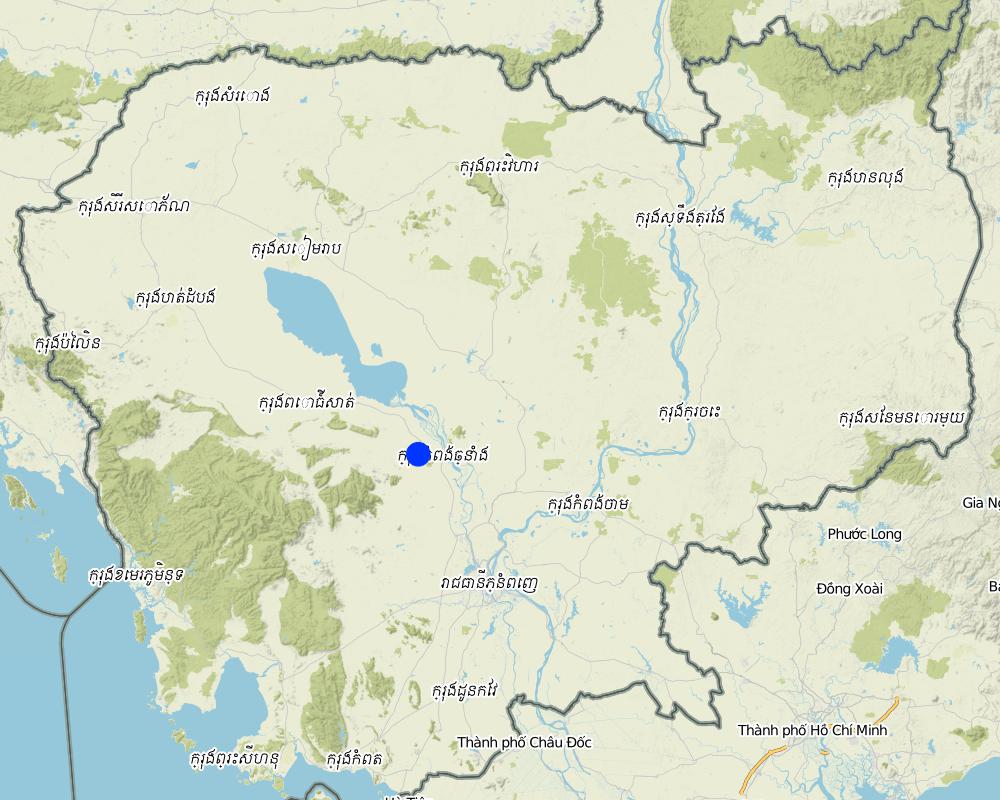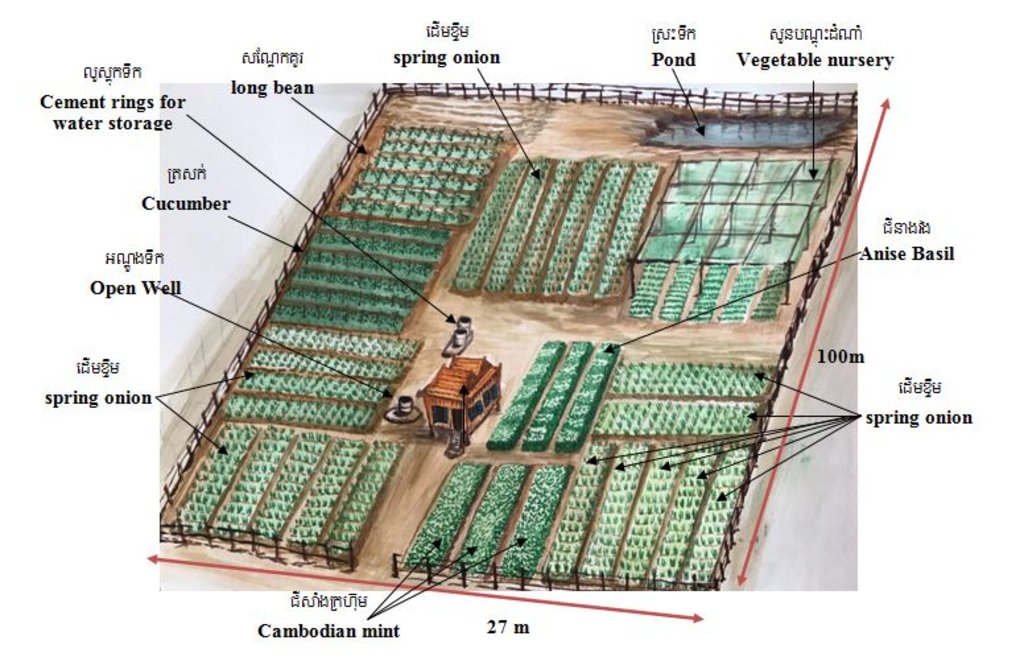Crop diversification with the application of rotation techniques [Камбоджа]
- Создание:
- Обновить:
- Составитель: Navin Chea
- Редакторы: Sophea Tim, Sok Pheak
- Рецензенты: Nimul CHUN, Ursula Gaemperli, Alexandra Gavilano
Crop diversification farm
technologies_3145 - Камбоджа
Просмотреть разделы
Развернуть все Свернуть все1. Общая информация
1.2 Контактные данные специалистов и организаций, участвующих в описании и оценке Технологии
Ответственный (-ые) специалист (-ы)
землепользователь:
Phrum Thon
Land User
Камбоджа
Vice Chief of Agronomy Office at Agricultural Office of Rolea B'ier:
Chhim Bunleang
Agricultural Office of Rolea B'ier.
Камбоджа
Vice Chief of Agricultural Extension Office at Provincial Department of Agriculture, Forestry and Fisheries, Kampong Chhnang province:
Chief of Agricultural Office of Tuek Phos:
Название проекта, содействовавшего документированию/оценке Технологии (если применимо)
Scaling-up SLM practices by smallholder farmers (IFAD)Название организации (-ий), содействовавших документированию/оценке Технологии (если применимо)
Royal University of Agriculture (RUA) - Камбоджа1.3 Условия, регламентирующие использование данных, собранных ВОКАТ
Составитель и ответственный(-ые) специалист(-ы) согласны с условиями, регламентирующими использование собранных ВОКАТ данных:
Да
1.4 Декларация по устойчивости описываемой Технологии
Вызывает ли описанная здесь Технология проблемы деградации земель настолько, что ее нельзя назвать природосберегающей?
Нет
2. Описание Технологии УЗП
2.1 Краткое описание Технологии
Определение Технологии:
Crop diversification is the practice of simultaneously cultivating two or multiple varieties of crops in a given area whilst at the same time applying crop rotation and/or intercropping. In this case study the land user has been practicing crop diversification with eleven different crop varieties.
2.2 Подробное описание Технологии
Описание:
Crop diversification entails simultaneously growing two or multiple varieties of crops in a particular place with the application of crop rotation techniques and/or intercropping. The selection of the crop varieties will depend on the purpose of the land user. In general, a diversity of crops will provide a range of benefits such as food security, nutritional diversity, income generation, soil conservation, pest and disease control as well as adaptation to climate change (CGIAR, 2017, Makate et al, 2016, MoEYS& VVOB Cambodia, 2013).
Mrs. Prum Thon has been cultivating a diversity of crops with the application of rotation techniquesfor about 10 years, which involves exchanging an entire crop in a particular row. This means that cultivation can take place throughout the year without having to leave the land fallow. At the time of the interview eleven different crops had been cultivated including spring onions, anise basil, Cambodian mint, bok choy, choy sum, escarole, mint, long beans, cucumbers, bitter melons and lettuce. Almost all of these crops have an average lifespan of three months, except for the anise basil which can grow for one or two years depending on the way it is cultivated. After she has harvested a particular crop, she will then rotate this crop row with a new distinctive crop species. For instance after having harvested spring onions she will then plant mint in that row, and in the row where she was previously growing mint, she will rotate that with either spring onions or cucumbers.
The practice of crop diversification whilst at the same time rotating the crop in each of the rows aims to achieve the following main objectives:
Crop diversification enables the farmer to generate a daily income to offset her daily expenses which thereby becomes a means of improving her livelihood. Growing a diversity of crops can also enable her to meet a variety of market demands and generate a high daily income. If a farmer grows only one crop specie she can usually earn about 15,000 Riel per day, but if she plants four crop species such as anise basil, bok choy, long beans and cucumbers she can increase her income to about 20,000 Riel per day, However if she grows one more specie such as lettuce or grows eleven different crops, she would be able to increase her income up to 40,000 or 80,000 Riel per day. The practice of crop diversification enables her to generate an income on a daily basis.
Crop diversification with the rotation of the crop in each row after the harvest could assist in reducing soil degradation. According to her experience and observations each crop absorbs different nutrients from the soil. If one row is repeatedly used to cultivate spring onions, they tend not to flourish so well and the roots have a tendency to decay. However if they are rotated with another crop and the spring onions are then grown in another row, they are able to thrive and the roots and stems are less likely to spoil. Crop diversification also has other functions as the cover crops help to reduce soil degradation through expose to sunlight, maintain soil moisture, make the soil less compact and add beneficial micro-organisms to the soil. In addition crop diversification can control pests especially the practice of growing companion plants such as herbs or spring onions as this can prevent crops from being damaged by pests.
The use of this technology assists in improving livelihoods, reduces migration because she does not need to move in order to find a job in another location, and enables her to generate a daily income. In addition this technology is able to reduce the risk of crop failure resulting from damage by pests and insects.Furthermore it reduces the risks associated with changes in market demand as the farmer produces a diversity of crops and also it prevents and reduces soil degradation. In order to effectively use this technology there needs to be sufficient water supply such as a river, stream, well or pond.This enables the land user to grow crops throughout the year round and reduces damage of crops as the result of unpredictable adverse climate conditions such as changes in rainfall, or the occurrence of drought.
2.3 Фотографии, иллюстрирующие Технологию
2.5 Страна/ регион/ места, где применяется Технология, информация о которых собрана в данной Анкете
Страна:
Камбоджа
Административная единица (Район/Область):
Ruessei Duoch village, Banteay Peal Commune, Rolea B'ier District, Kampong Chhnang Province.
Охарактеризуйте пространственное распространение Технологии :
- равномерно-однородное применение на определенной площади
Если технология равномерно занимает территорию, укажите площадь покрытия (в км2):
0,0027
Если точная область неизвестна, укажите приблизительную площадь:
- < 0,1 км2 (10 га)
Пояснения:
It is spread over an area of 2700 square meters.
Map
×2.6 Сколько лет применяется данная Технология
Если год начала применения Технологии достоверно неизвестен, дайте примерную оценку:
- 10-50 лет назад
2.7 Внедрение Технологии
Укажите, как именно Технология УЗП была внедрена:
- как инновация (инициатива) землепользователей
- в качестве научного/ полевого эксперимента
- через проекты/ внешнее вмешательство
Пояснения (тип проекта и т.д.):
Through her experience and training from Cambodian Center for Study and Development in Agriculture (CEDAC).
3. Классификация Технологии УЗП
3.1 Основные цели и задачи реализации Технологии
- повышение производства
- снижение или предотвращение деградации земель, восстановление нарушенных земель
- создание благоприятных экономических условий
3.2 Текущий(-ие) тип(-ы) землепользования на территории, где применяется Технология

Пахотные угодья и плантации
- Однолетние культуры
Ежегодный урожай - Уточните культуры:
- овощи - корнеплоды (морковь, лук, свекла, другие)
- овощи - дыня, тыква, сквош или тыква
- овощи - листовые овощи (салаты, капуста, шпинат, другие)
- бобовые - бобы
- лекарственные/ ароматические / пестицидные растения и травы
- cucumber
Годовая система земледелия:
Овощи - пшеница / ячмень / овес / суходольный рис
Число урожаев за год:
- 3
Поясните:
Crop rotation throughout the whole year. The land is alway coverd by corps (no fallow period).
Применяется ли севооборот?
Да
Пояснения:
Spring onion, anise basil, Cambodian mint, bok choy, escarole, choy sum, mint, long bean, cucumber, bitter melon, lettuce.
3.3 Изменилось ли использование земель в связи с внедрением Технологии?
Изменилось ли использование земель в связи с внедрением Технологии?
- Да (Пожалуйста, заполните нижеприведенные вопросы относительно использования земель до внедрения Технологии)

Леса/ лесистая местность
Пояснения:
Degraded forest land.
3.4 Водоснабжение
Обеспеченность водой участков, где реализуется Технология :
- сочетание богарных и орошаемых земель
Пояснения:
There is one open well and a pond for crop irrigation during drought.
3.5 Категория УЗП, к которой относится Технология
- ротационная система (севооборот, парование, переложное использование)
- Комплексное управление почвенным плодородием
- Комплексная борьба с сельскохозяйственными вредителями и болезнями (включая органическое сельское хозяйство)
3.6 Мероприятия УЗП, выполняемые в рамках Технологии

Агрономические мероприятия
- A1: Растительный/ почвенный покров
- A2: Органическое вещество/ почвенное плодородие

инженерные мероприятия
- И5: Дамбы, водохранилища, пруды

другие мероприятия
Пояснения:
The farmer grows specific companion plants on the same plot with the aim of improving the plant growth and the pest control.
3.7 Основные проблемы деградации земель, на решение которых направлена Технология

ухудшение химических свойств почв
- Хп: Снижение плодородия и уменьшение содержания органического вещества (вызванное не эрозией, а другими причинами)

ухудшение физических свойств почв
- Фу: уплотнение

биологическая деградация
- Бр: сокращение растительного покрова
- Бв: потеря природного разнообразия
- Бф: утрата биологической составляющей почв
- Бб: рост числа вредителей/болезней
3.8 Предотвращение и снижение деградации земель, или восстановление нарушенных земель
Укажите цель Технологии по отношению к деградации земель :
- предотвращение деградации земель
- снижение деградации земель
Пояснения:
At the first time when she cultivated the land the soil was fertile. At that time she grew only cassava but she realized soon that if she grows always the same crop, the soil will be less fertile from year to year.
4. Технические характеристики, мероприятия по практической реализации, вложения и стоимость
4.1 Технический рисунок, иллюстрирующий Технологию
Спецификация (пояснения к техническому рисунку):
The total area on which the technology has been applied amounts to 2700 square meters (27 meters x 100 meters). Each of the diverse crop species such as spring onions, anise basil, bok choy, choy sum, escarole, Cambodian mint, long beans, bitter melons and lettuce have been divided into separate blocks.
The spring onion crop has been divided into 5 blocks out of which the first block measures 8.50 m x 8.50 m = 72.25 square meters and it contains a total of five rows. The length of each row is 8.50 m and width is 1.4 m and space between each row is 4 centimeters. The second block measures 14.60 m x 13 m= 189.3 square meters and it has been divided into two rows. Each row is 14.60 m in length and has a width of 1.4 m with a space of 4cm between the two rows. The third block measures 9.60 m x 3.90 m= 37.44 square meters and it contains 6 rows. Each of the rows is 9.60 m x 1.4 m and the space between each of the rows is 4 cm. The fourth block measures 6.35 m x 4.55 m= 28.89 square meters and it is divided into 4 rows. Each of the rows is 6.35 m in length and 1.4 m in width, and the space between each of the rows is 4 cm. The fifth block measures 11.60 m x 14.70 m = 170.52 square meters and it contains 6 rows. Each of the rows is 11.60 m in length, and 1.5 m in width and the space between each of the rows is 4 cm.
The block in which the anise basil is grown is 14.60 meters in length and 1.4 meters in width with a 4 cm space between the 3 rows. The block of cucumbers is divided into 6 rows with the length of each row being 10 meters and the width being0.5 meters. Each row rises to a height of about 1.5 cm and within the row the space between each cucumber clump is 0.5 cm. In the block of the long beans there are 6 rows with each row being 10 meters in length and 0.5 meters in width. Additionally the height of each row is 1.5 cm and space between each clump of long beans is 2 cm.
The nursery containing escarole, choy sum and lettuce is 14.60 meters x 13.50 meters and its roof has a height of 2 meters. There are two cement rings which also have a cement base that have been constructed for water storage. Each cement ring is 1 meter in height and 1 meter in diameter. Furthermore there is also one open well and a pond which provide water for domestic supply and the irrigation of crops.
Автор:
Mr. Khoun Sophal
Дата:
22/05/2017
4.2 Общая информация по необходимым вложениям и стоимости
Уточните, как рассчитывались затраты и вложения:
- на площадь, где применяется Технология
Укажите размер и единицу площади:
2700 square meters
другая/ национальная валюта (название):
KHR
Если это необходимо, укажите обменный курс от доллара США к местной валюте (например, 1 доллар США = 79,9 бразильского реала): 1 доллар США =:
4000,0
Укажите среднюю дневную заработную плату наемных работников:
15000
4.3 Мероприятия, необходимые для начала реализации
| Деятельность | Время (сессия) | |
|---|---|---|
| 1. | Dig open well | During dry season |
| 2. | Dig pond | During dry season |
| 3. | Plough the soil two times and dry the soil by sunlight | After harvest |
| 4. | Buy crop seeds | At the beginning of soil preparation |
| 5. | Prepare pipe lines into cement rings | At the beginning of soil preparation |
| 6. | Buy net to cover the roof of the nursery house | At the beginning of soil preparation |
| 7. | Buy materials such as spit, handled basket, hoe ect | At the beginning of soil preparation |
4.4 Вложения и затраты, необходимые для начала реализации
| Опишите затраты | Единица | Количество | Затраты на единицу | Общая стоимость на единицу | % затрат, оплаченных землепользователями | |
|---|---|---|---|---|---|---|
| Оплата труда | Plough the soil for the first and second time | person-day | 11,0 | 15000,0 | 165000,0 | 100,0 |
| Оплата труда | Clear land for growing 11 different crops | person-day | 15,0 | 15000,0 | 225000,0 | 100,0 |
| Оплата труда | Dig the open well and put the cement ring | person-day | 84,0 | 15000,0 | 1260000,0 | 100,0 |
| Оплата труда | Dig pond | person-day | 133,0 | 15000,0 | 1995000,0 | 100,0 |
| Оборудование | Bamboo sticks | Piece | 50,0 | 1500,0 | 75000,0 | 100,0 |
| Оборудование | Hoe | Piece | 2,0 | 17000,0 | 34000,0 | 100,0 |
| Оборудование | Spit | Piece | 2,0 | 1300,0 | 2600,0 | 100,0 |
| Оборудование | Handle basket to carry soil | Pair | 1,0 | 6000,0 | 6000,0 | 100,0 |
| Посадочный материал | Spring onion | Kilogram | 10,0 | 1000,0 | 10000,0 | 100,0 |
| Посадочный материал | Bok choy | Can | 12,0 | 1500,0 | 18000,0 | 100,0 |
| Посадочный материал | Escarole | Package | 2,0 | 10000,0 | 20000,0 | 100,0 |
| Посадочный материал | Choy Sum | Can | 5,0 | 1500,0 | 7500,0 | 100,0 |
| Посадочный материал | Anise basile | Package | 1,0 | 15000,0 | 15000,0 | 100,0 |
| Посадочный материал | Mint | Kilogram | 3,0 | 4000,0 | 12000,0 | 100,0 |
| Посадочный материал | Cambodian mint | Kilogram | 2,0 | 2500,0 | 5000,0 | 100,0 |
| Посадочный материал | Long bean | Kilogram | 1,0 | 60000,0 | 60000,0 | 100,0 |
| Удобрения и ядохимикаты | Buy cow manure for the use of one year | Two wheel handle tractor | 10,0 | 70000,0 | 700000,0 | 100,0 |
| Удобрения и ядохимикаты | Buy chicken manure for the use of one year | Bag | 20,0 | 4000,0 | 80000,0 | 100,0 |
| Удобрения и ядохимикаты | Buy soil of termite mounds | Two wheel handle tractor | 10,0 | 40000,0 | 400000,0 | 100,0 |
| Удобрения и ядохимикаты | Buy botanical pesticides | Liter | 6,0 | 4000,0 | 24000,0 | 100,0 |
| Удобрения и ядохимикаты | Rice husk | Bag | 30,0 | 1500,0 | 45000,0 | 100,0 |
| Удобрения и ядохимикаты | Buy Bat manure for soil preparation | Bag | 5,0 | 70000,0 | 350000,0 | 100,0 |
| Строительные материалы | Water Pumping Machine | Piece | 2,0 | 880000,0 | 1760000,0 | 100,0 |
| Строительные материалы | Cement rings which also have a cement base that have been constructed for water storage to irrigate crops. | Piece | 2,0 | 70000,0 | 140000,0 | 100,0 |
| Строительные материалы | Net for making the roof to prevent sunlight and water. | Set | 2,0 | 220000,0 | 440000,0 | 100,0 |
| Другие | Cucumber | Can | 1,0 | 40000,0 | 40000,0 | 100,0 |
| Другие | Lettuce | Package | 5,0 | 15000,0 | 75000,0 | 100,0 |
| Другие | Bitter melon | Package | 2,0 | 5000,0 | 10000,0 | 100,0 |
| Общая стоимость запуска Технологии | 7974100,0 | |||||
| Общие затраты на создание Технологии в долларах США | 1993,53 | |||||
Пояснения:
Generally, the rate for digging a pond in Cambodia is USD 50 per hour if the contractor does not obtain the soil, but if he does the cost of digging the pond will be less. Cost calculations of this technology are based on crop cycles (the average lifespan of crop being three months with a diversity of eleven crops). The farmer uses her own labor force to implement this technology without hiring any external labor. In reference to the costs indicated in the table above, there may be minor errors compared to the actual costs because the land user did not make exact records, and the costs that were provided are only estimates.
4.5 Поддержание/ текущее обслуживание
| Деятельность | Сроки/ повторяемость проведения | |
|---|---|---|
| 1. | Watering | Two times per day or three times per day depend on the weather. |
| 2. | Apply cow manure | When dig the soil near the crop root. |
| 3. | Apply bat manure | When dig the soil near the crop root. |
| 4. | Weeding | Once a week |
| 5. | Spraying pesticides | When there is insects. |
4.6 Стоимость поддержания/ текущего обслуживания ( в год)
| Опишите затраты | Единица | Количество | Затраты на единицу | Общая стоимость на единицу | % затрат, оплаченных землепользователями | |
|---|---|---|---|---|---|---|
| Оплата труда | When weeding, dig the soil near the crop root and apply fertilizer for elevent diversify of crops. | Person-day | 12,0 | 15000,0 | 180000,0 | 100,0 |
| Оплата труда | Spray pesticides | Person-day | 3,0 | 15000,0 | 45000,0 | 100,0 |
| Оборудование | Diesel | liter | 10,0 | 3000,0 | 30000,0 | 100,0 |
| Удобрения и ядохимикаты | Liquid fertilizer made of bat manure buying from fertilizer company. | liter | 1,0 | 70000,0 | 70000,0 | 100,0 |
| Общая стоимость поддержания Технологии | 325000,0 | |||||
| Общие затраты на поддержание Технологии в долларах США | 81,25 | |||||
Пояснения:
The estimated maintenance costs base on one crop cycle of 3 months. It is not calculatee for the whole year. The land user does not hire wageworker as she is doing the work by herself and by the support of her husband.
4.7 Наиболее значимые факторы, влияющие на стоимость затрат
Опишите наиболее значимые факторы, влияющие на стоимость затрат:
Cow manure, chicken manure, rice husk, botanical pesticides has to be bought. Digging the pond and buying the water pumping machine are the most important factors affecting the costs. However these equipments are longlasting.
5. Природные и социально-экономические условия
5.1 Климат
Среднегодовое количество осадков
- < 250 мм
- 251-500 мм
- 501-750 мм
- 751-1000 мм
- 1001-1500 мм
- 1501-2000 мм
- 2001-3000 мм
- 3001-4000 мм
- > 4000 мм
Укажите среднегодовое количество осадков (если известно), мм:
1209,00
Пояснения/ комментарии по осадкам:
The annual rainfall in 2015 is 1209 mm. In 2014 is 1420.74 mm and in 2013 is 1367.5 mm
Укажите название соответствующей метеостанции:
Ministry of water resources and meteorology, 2015
Агроклиматическая зона
- Умеренно-влажная
There are two seasons: Rainy season and dry season.
5.2 Рельеф
Склоны (преобладающие):
- пологие (0-2%)
- покатые (3-5%)
- покато-крутые (6-10%)
- крутые (11-15%)
- очень крутые (16-30%)
- чрезвычайно крутые (31-60%)
- обрывистые (>60%)
Формы рельефа:
- плато/ равнины
- гребни хребтов/холмов
- склоны гор
- склоны холмов
- подножья
- днища долин
Зона высотной поясности:
- 0-100 м над уровнем моря
- 101-500 м н.у.м.
- 501-1000 м н.у.м.
- 1001-1500 м н.у.м.
- 1501-2000 м н.у.м.
- 2001-2500 м н.у.м.
- 2501-3000 м н.у.м.
- 3001-4000 м н.у.м.
- > 4 тыс. м н.у.м.
Укажите, приурочено ли применение Технологии к специфическим условиям:
- не имеет значения
5.3 Почвы
Средняя мощность почв:
- поверхностные (0-20 см)
- неглубокие (21-50 см)
- умеренно глубокие (51-80 см)
- глубокие (81-120 см)
- очень глубокие (> 120 см)
Гранулометрический состав (верхнего горизонта):
- грубый крупнозернистый/ лёгкий (песчаный)
Гранулометрический состав (на глубине более 20 см):
- средние фракции (суглинистый, супесчаный)
Содержание органического вещества в верхнем горизонте:
- среднее (1-3%)
Если возможно, приложите полное описание почв или укажите доступную информацию, например тип почв, рH/ кислотность почв, ёмкость катионного обмена, содержание азота, содержание солей и т.д.
PH=6
5.4 Доступность и качество воды
Уровень грунтовых вод:
5-50 м
Доступность поверхностных вод:
хорошая
Качество воды (без обработки):
питьевая вода хорошего качества
Является ли солёность воды проблемой?
Нет
Происходят ли периодические затопления территории?
Нет
5.5 Биоразнообразие
Видовое разнообразие:
- средняя
Разнообразие местообитаний:
- средняя
5.6 Характеристика землепользователей, применяющих Технологию
Осёдлый или кочевой:
- Осёдлый
Рыночная ориентация производства:
- товарное/ рыночное хозяйство
Доходы из других источников:
- 10-50% всех доходов
Относительный уровень достатка:
- средний
Индивидуальное или коллективное хозяйство:
- частное/ домовладение
Уровень механизации:
- ручной труд
- механизировано/ есть автотранспорт
Пол:
- женщины
Возраст землепользователей:
- пожилой
Укажите другие важные характеристики землепользователей:
In this technology only two persons are involved in the technology (husband and wife). The interviewee is the wife is 50 years old. She finished grade 8.
5.7 Средняя площадь земель, используемых землепользователями с применением Технологии
- < 0,5 га
- 0,5-1 га
- 1-2 га
- 2-5 га
- 5-15 га
- 15-50 га
- 50-100 га
- 100-500 га
- 500-1000 га
- 1000-10000 га
- > 10000 га
Считается ли это мелким, средним или крупным хозяйством (по местным масштабам)?
- среднего размера
Пояснения:
The technology is applied on 2,700 square meters. The homeland is 3,900 square meters. Degraded forest land is 8,250 square meters and rice paddy field is 0.50 hectare.
5.8 Собственность на землю, права на земле- и водопользование
Землевладелец:
- индивидуальная, оформленная в собственность
Право землепользования:
- индивидуальное
Право водопользования:
- индивидуальное
5.9 Доступ к базовым услугам и инфраструктуре
медицинское обслуживание:
- плохой
- средний
- хорошая
образование:
- плохой
- средний
- хорошая
технические консультации:
- плохой
- средний
- хорошая
занятость (вне хозяйства):
- плохой
- средний
- хорошая
рынки:
- плохой
- средний
- хорошая
электроснабжение:
- плохой
- средний
- хорошая
транспорт и дорожная сеть:
- плохой
- средний
- хорошая
водоснабжение и канализация:
- плохой
- средний
- хорошая
финансовые услуги:
- плохой
- средний
- хорошая
6. Воздействия и заключительные положения
6.1 Влияние Технологии УЗП в пределах территории ее применения
Социально-экономическое воздействие
Продуктивность
производство сельскозяйственных культур
Комментарий/ пояснения:
The crop diversification and the subsequent cultivation of vegetables and herbs during the whole year, as well as the distinct crop rotational plan increased considerably her crop production.
качество урожая
Комментарий/ пояснения:
The application of natural fertilizers and botanical pesticides, as well as the method of crop rotation and selection of companion plants led to better crop quality.
риск потери продуктивности
Комментарий/ пояснения:
Due to the permanent soil cover, the high crop diversification and the sophisticated pest control the risk of production failure decreased.
разнообразие продукции
Комментарий/ пояснения:
There are diversify of crops and grow all year round.
Доступность и качество воды
потребность в оросительной воде
Комментарий/ пояснения:
The plantation of a large variety of vegetables and herbs all year round let to higher irrigation water demand especially during the dry season or at drought events.
Доходы и затраты
сельскохозяйственные издержки
Комментарий/ пояснения:
The crop diversification requires a lot of monetary inputs mainly for the establishment and also for the maintenance (labor for digging the pond, water pumping machine, natural fertilizers has to be bought - she does not raise animals).
доходы хозяйства
Комментарий/ пояснения:
Although the land user had to invest a lot of money for this technology, she got and get still better and regular daily income from the sale of the wide range of different crops at the market compared to what she earned before. All in all she was able to improve the household's livelihood.
объем работ
Комментарий/ пояснения:
This technology is sophisticated and rather time consuming compared to conventional growing methods (mono-cropping of cassava for example). In this case study the land user invests only her own and her husband's labor force.
Социальное и культурное воздействие
продовольственная безопасность/ самообеспечение
Комментарий/ пояснения:
The self sufficiency increased as she gets every day her own vegetables from the vegetable plot. And at a daily base she gets money from the sale of her vegetables to meet all needs of the household. Further, she was able to reduce the risk of crop failure which increased the food security.
состояние здоровья
Комментарий/ пояснения:
The health situation of the farmer and her husband were improved as the production is near to be fully organic very low use of chemical pesticides/biocides. And by the health production she supports also the health of the other consumers.
знания в области УЗП/ деградации земель
Комментарий/ пояснения:
The land user got a broad knowledge about the crop diversification and crop rotation technology. Mainly regarding the reduction of chemical soil degradation and regarding how to support better plant growth.
Экологическое воздействие
Водный цикл/ поверхностный сток
качество воды
Комментарий/ пояснения:
Due to very low application of chemical pesticides.
испарение
Комментарий/ пояснения:
Due to the improved soil cover by the different vegetables and herbs all year long the evaporation deceased.
Почвы
влажность почв
Комментарий/ пояснения:
Soil moisture increased due to the improved soil cover that could reduce evaporation into environment.
уплотнение почв
Комментарий/ пояснения:
The soil compaction is less due to better soil moisture, crop rotation and using natural fertilizers.
почвенное / подземное органическое вещество/ углерод
Комментарий/ пояснения:
The soil organic matter increased due to the application of natural fertilizers.
Биоразнообразие: растительность, животный мир
Растительный покров
Комментарий/ пояснения:
All year long the soil is covered by different vegetables and herbs.
разнообразие флоры
Комментарий/ пояснения:
Before she has cultivated only one crop on the area but she grows now eleven different vegetables and herbs.
полезные виды
Комментарий/ пояснения:
The soil life increased regarding bacteria and fungi, earthworm, ant, and centipede due to the crop rotation system and the use of natural fertilizers and botanical pesticides.
разнообразие местообитаний
Комментарий/ пояснения:
The nearly organic cultivation provides a habitat for a large variety of soil organisms such as earthworm, termites or ants.
борьба с вредителями/ болезнями
Комментарий/ пояснения:
The pest and disease control is improved due to the rotational system, the use of botanical pesticides, and the cultivation of companion plants such as anise basil, Cambodian mint and spring onions.
6.3 Подверженность и чувствительность Технологии УЗП к постепенным изменениям климата и экстремальным погодным явлениям/ стихийным бедствиям, связанным с изменением климата (в понимании землепользователей)
Постепенное изменение климата
Постепенное изменение климата
| Сезон | увеличение или уменьшение | Насколько успешно Технология справляется с этим? | |
|---|---|---|---|
| среднегодовые температуры | снизилось | хорошо | |
| сезонные температуры | сезон дождей/ влажный сезон | снизилось | хорошо |
| сезонные температуры | сухой сезон | увеличилось | хорошо |
| среднегодовое количество осадков | снизилось | хорошо | |
| сезонное количество осадков | сезон дождей/ влажный сезон | снизилось | хорошо |
Экстремальные явления, связанные с изменением климата (стихийные бедствия)
Стихийные бедствия климатического характера
| Насколько успешно Технология справляется с этим? | |
|---|---|
| засухи | хорошо |
Биологические стихийные бедствия
| Насколько успешно Технология справляется с этим? | |
|---|---|
| эпидемии | умеренно |
| нашествия насекомых/ поражения червями | хорошо |
6.4 Анализ эффективности затрат
Насколько получаемый результат сопоставим с первоначальными вложениями (с точки зрения землепользователей)?
Эффективность затрат в краткосрочной перспективе:
позитивное
Эффективность затрат в долгосрочной перспективе:
позитивное
Насколько получаемый результат сопоставим с текущими расходами по поддержанию технологии (с точки зрения землепользователей)?
Эффективность затрат в краткосрочной перспективе:
позитивное
Эффективность затрат в долгосрочной перспективе:
позитивное
6.5 Внедрение Технологии
- 11-50%
Если возможно, дайте количественную характеристику (число домохозяйств и/или площадь применения):
7 families
Среди применяющих Технологию землепользователей, какова доля лиц, применяющих её по собственной инициативе, т.е. без какого-либо материального стимулирования со стороны?
- 91-100%
6.6 Адаптация
Была ли Технология УЗП изменена в недавнее время с целью адаптации к меняющимся условиям среды?
Нет
6.7 Сильные стороны/ преимущества/ возможности Технологии
| Сильные стороны/ преимущества/ возможности по мнению землепользователей |
|---|
| Provides a daily income. |
| The quality of the soil is better through crop rotation and the exchange of crops in the rows. Additionally cow manure and soil from the termite mound can be used as fertilizer. |
| The actual work can be done by oneself which involves physical exercise and is good for one’s health. |
| Сильные стороны/ преимущества/ возможности по мнению составителя или других ключевых специалистов |
|---|
| Grow a diversity of crops which reduces the risk of production failure from damaging from insects, disease and market. |
| The farmer is able to generate a daily income, thereby improving her livelihood and it gives her the means to cope with her daily expenses. |
| Crop rotation could reduce soil degradation. |
| Reduces migration as now she has her own job and as this technology improves her livelihood. |
6.8 Слабые стороны/ недостатки/ риски Технологии и пути их преодоления
| Слабые стороны/ недостатки/ риски по мнению землепользователей | Возможные пути их преодоления/снижения? |
|---|---|
| During some months it is not possible to grow herbage vegetables. | Can grow other crops such as anise basil. |
| She has to water the crops only by herself which is very exhausting | Must try harder. |
| Слабые стороны/ недостатки/ риски по мнению составителя или ответственных специалистов | Возможные пути их преодоления/снижения? |
|---|---|
| Farmer spends a lot of time for watering the crops. | Could change and start using a sprinkler or drip irrigation system in order to reduce labor. |
| Must properly record expenses and income so as to verify the net income. | Provide training in recording income and expenses. |
7. Справочные материалы и ссылки
7.1 Методы сбора/ источники информации
- выезды на места, полевые обследования
One specific location where the technology applied.
- опросы землепользователей
one person
- опросы специалистов/экспертов по УЗП
3 persons
Когда были собраны данные (на местах)?
22/05/2017
7.3 Ссылки на соответствующую онлайн-информацию
Название/ описание:
CGIAR. (2017). Crop diversification strategies for Cambodia, Laos and Vietnam. Retrieved December 11, 2017, from
Адрес в сети Интернет:
https://ccafs.cgiar.org/blog/crop-diversification-strategies-cambodia-laos-and-vietnam#.Wi4Hu1WWbIU
Название/ описание:
Makate, C., Wang, R., Makate, M., & Mango, N. (2016). Crop diversification and livelihoods of smallholder farmers in Zimbabwe: adaptive management for environmental change. SpringerPlus, 5(1), 1135.Retrieved December 11, 2017, from
Адрес в сети Интернет:
https://doi.org/10.1186/s40064-016-2802-4
Название/ описание:
MAFF. (2006). Technology stardardize: Home gardening. In Khmer. (Ministry of Agriculture, Forestry and Fisheries). Phnom Penh. Retrieved December 11, 2017, from
Адрес в сети Интернет:
https://drive.google.com/file/d/0B3kkBprEzhDoMWtPeXZUNE4teTQ/preview
Название/ описание:
MoEYS & VVOB Cambodia. (2013). Teaching Methodology for Agricultural Life Skills Education for Teacher Training Centers:Part 3 Organic gardening (1st editio). Phnom Penh: Ministry of Education, Youth and Sport. Retrieved December 11, 2017, from
Адрес в сети Интернет:
http://www.vvob.be/cambodia/sites/default/files/content_manual_part_3_organic_gardening.pdf
Ссылки и модули
Развернуть все Свернуть всеСсылки
Нет ссылок
Модули
Нет модулей


